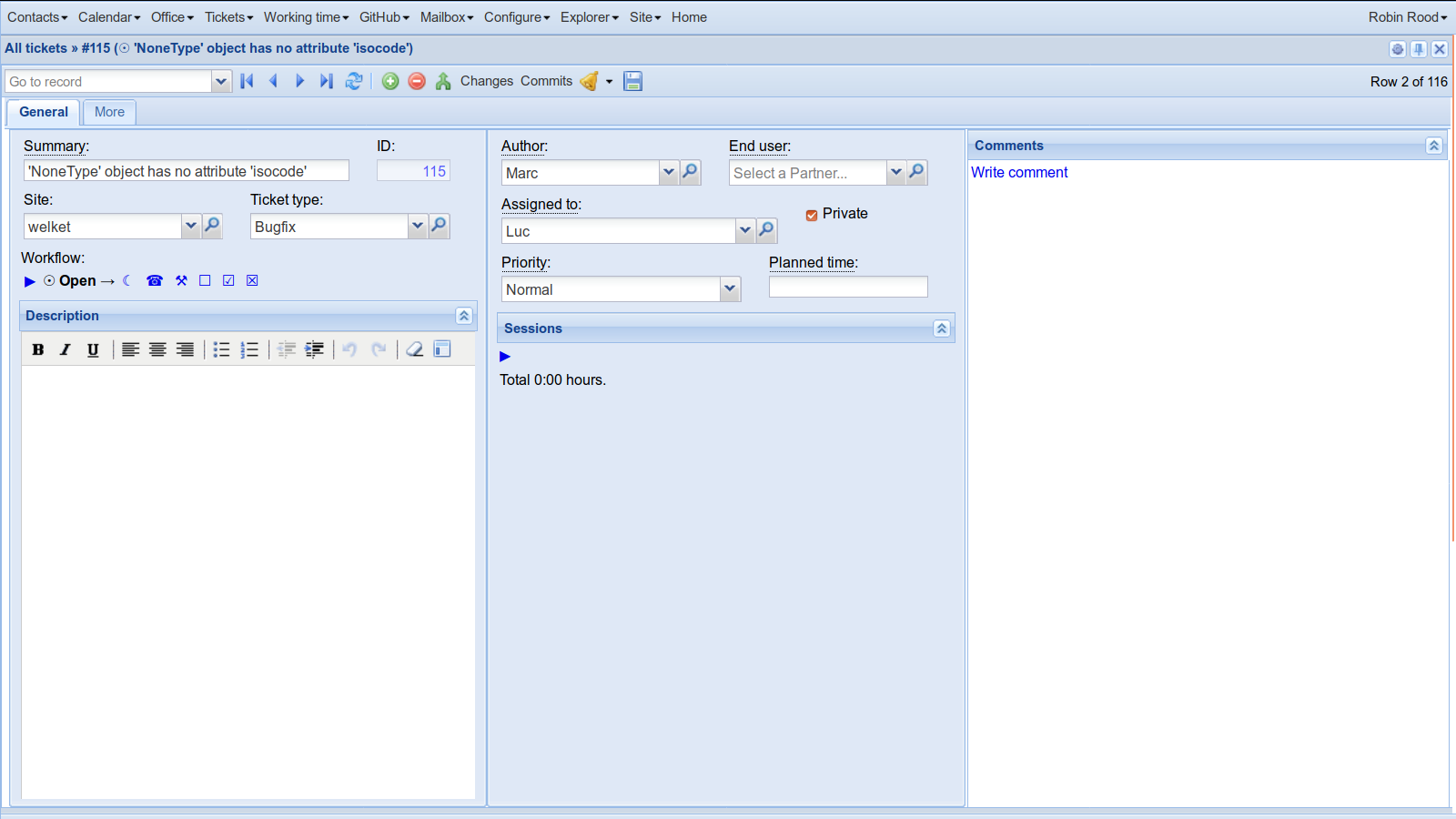Thursday, December 6, 2018¶
Tonis asked some information about the internals of Lino.
We used a ticket detail as example.

The following snippets were tested using doctest docs/blog/2018/1206.rst
>>> from lino import startup
>>> startup("lino_book.projects.team.settings.demo")
>>> from lino.api.doctest import *
>>> # lh = rt.models.tickets.Tickets.actions['detail'].get_layout_handle()
A layout is the “uncompiled” representation of a window.
>>> dl = rt.models.tickets.Tickets.detail_layout
>>> rmu(dl.main)
'general more #history_tab #more2 #github.CommitsByTicket'
main is always a string. If it contains no newline, the layout will be rendered in extui3 using a TabPanel, otherwise using a simple FormPanel.
main is a “descriptor”, i.e. a space-separated list of names. Every name in a descriptor must either match an attribute of the layout or a data element of the underlying datasource.
If it matches an attribute of the layout, it can be either a string (i.e.
another descriptor of a data element or a group thereof) or a layout panel (an
instance of lino.core.layouts.Panel, not to be mixed up with Panel
elements, see later).
In our example, general is a panel while general1a is just a
simple (multiline) string descriptor.
>>> p = dl.general
>>> p
<lino.core.layouts.Panel object at ...>
>>> print(p.options)
{'label': u'General'}
>>> print(p.desc)
general1:60 comments.CommentsByRFC:30
>>> print(dl.general1a)
summary id:6
site ticket_type
workflow_buttons
description
The “handle” of a layout has been factored from a given layout by the front-end (extui3).
>>> lh = rt.models.tickets.Tickets.detail_layout.get_layout_handle()
>>> lh
<lino.core.layouts.LayoutHandle object at ...>
>>> lh.main
<TabPanel main in lino_noi.lib.tickets.models.TicketDetail on lino_xl.lib.tickets.ui.Tickets>
>>> lh.main.elements
(<Panel general_1 in lino_noi.lib.tickets.models.TicketDetail on lino_xl.lib.tickets.ui.Tickets>, <Panel more in lino_noi.lib.tickets.models.TicketDetail on lino_xl.lib.tickets.ui.Tickets>)
Before continuing we must set a “current user type” because methods like
lino.utils.jsgen.Companent.walk()
and lino.utils.jsgen.Companent.find_by_name()
filter out elements for which the current user has no view
permission.
>>> from lino.modlib.users.utils import set_user_profile
>>> robin = rt.login("robin").get_user()
>>> set_user_profile(robin.user_type)
>>> def show(k):
... e = lh.main.find_by_name(k)
... print("width: {}, preferred_width: {}".format(e.width, e.preferred_width))
>>> show("summary")
width: None, preferred_width: 21
>>> show("id")
width: 6, preferred_width: 5
>>> show("general1a")
width: 30, preferred_width: 60
Note that for the general layout attribute there is no element because
it becomes a panel:
>>> print(lh.main.find_by_name("general"))
None
Actually a panel is a special kind of element (a container) and is stored in it’s parent’s elements attribute:
>>> lh.main.elements
(<Panel general_1 in lino_noi.lib.tickets.models.TicketDetail on lino_xl.lib.tickets.ui.Tickets>, <Panel more in lino_noi.lib.tickets.models.TicketDetail on lino_xl.lib.tickets.ui.Tickets>)
Let’s have a look at the first tab panel:
>>> general_1 = lh.main.elements[0]
It has a label (all tab panels must have a label):
>>> print(general_1.get_label())
General
It contains two panels, one normal panel and one slave summary panel:
>>> general_1.elements
[<Panel general1_1 in lino_noi.lib.tickets.models.TicketDetail on lino_xl.lib.tickets.ui.Tickets>, <SlaveSummaryPanel comments_CommentsByRFC in lino_noi.lib.tickets.models.TicketDetail on lino_xl.lib.tickets.ui.Tickets>]
One field panel and one slave summary panel:
>>> pe = general_1.elements[0]
The “normal” panel contains itself again two subpanels
>>> len(pe.elements)
2
>>> pe = pe.elements[0]
Note that the __init__ of a Panel (element) has quite complex code to analyze its elements and to set certain attributes. This is quite extjs-focussed code.
>>> pe.vertical
True
>>> pe.vflex
True
>>> pe.width
30
>>> pe.preferred_width
60
>>> pe.height
>>> pe.preferred_height
10
>>> pe.value
{'hideCheckBoxLabels': True, u'layoutConfig': {'align': u'stretch'}, u'layout': u'vbox', 'flex': 50}
The value is adict with options. This is clearly for ExtJS-only (we should move this from core to extui3… but that might be some work and might cause nasty bugs). The value is used together with the value_template to generate JS code for the ExtJS component:
>>> pe.value_template
u'new Ext.Panel(%s)'
In lino.core.elems you have code like this which updates the value:
w = self.width or self.preferred_width
kw.update(width=js_code("Lino.chars2width(%d)" % (w + 1)))
Hamza is working on Lino Presto and asked where we can define a price for a product.